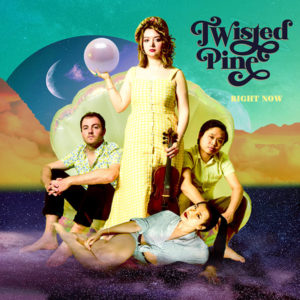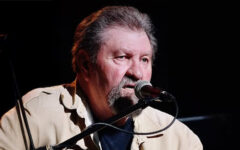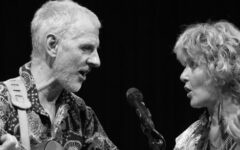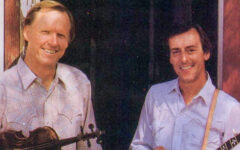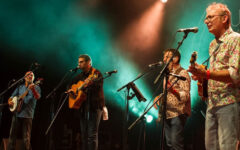
While any number of new bands have helped push the parameters of traditional bluegrass, few have done so with more diligence than Twisted Pine. Their roots were planted in traditional ground at the outset of their collective careers, as evidenced by their eponymous full length debut. Yet by the time they released their second effort, a covers EP titled Dreams, the Boston-based combo was well on its way to altering their trajectory. Their new album, appropriately dubbed Right Now, offers a remarkable confluence of styles and influences, including not only bluegrass, but also jazz, Celtic music, prog and a jam band motif. There’s a decided element of verve and variety that finds the quartet — currently consisting of Kathleen Parks (singer, songwriter, and fiddle), Chris Sartori (bass, percussion, vocals and whistles), Dan Bui (mandolin and vocals), and newest member Anh Phung (flute, vocals, harmony, and whistles) — daring to push the parameters and bend some boundaries all at the same time.
“The influences started out in bluegrass,” Parks explains. “Our first full-length album mostly consisted of original songs and it had that bluegrass element in there. But then when we made our EP, that encompassed a wide range of covers, from Bill Monroe to the Beatles to Joni Mitchell. Because of that EP, we were able to really explore a lot of different genres. We also had the influence of our schooling. Chris, our bass player, studied jazz bass and that’s where he got his musical foundation. Dan, our mandolin player, is really rooted in traditional bluegrass, but was also rooted in the jam scene. For me, my fiddle playing started with Celtic music, but at Berkelee, I studied American roots, bluegrass, and blues.”
“I grew up playing rock and roll and then I got into jazz, and I took a long musical journey that allowed me to discover other musical genres,” Phung notes. “However, I was really attracted to bluegrass in particular. So here you have a bluegrass band that was interested in other music, and then on top of that, you add a flute player who’s also interested in bluegrass and it becomes a perfect mix. I was emulating mandolin and fiddle chops on my flute, and in a way, it creates this new sound that you don’t hear very often.”
“Bluegrass was our common ground,” Parks adds. “We shared a lot of fun fiddle tunes that we heard at bluegrass festivals, and we did a lot of band competitions early on, like at FreshGrass in particular. We were doing very well when we began as a bluegrass band, and that was the common thread. Then eventually I started to bring in my songs and I asked the other members of the band if they might be interested in covering them. I really wanted to get their feedback. Eventually everyone started bringing in material, so now we all write pretty equally. Everybody brings their input in a very creative way. That’s how it all started developing over time.”
Nevertheless, there’s always the danger that when a band starts coloring outside the lines, fans of of a more traditional template will turn their backs and consider it heretical in a way. Parks acknowledges that they did have to deal with that criticism at one time, although now their audiences appear more accepting of their efforts.
“We were encountering that attitude early on,” she admits. “But that’s when we were playing more bluegrass music to begin with. We still play that music because we love it, and we still cover a lot of traditional songs on stage. We’re sharing some songs that people haven’t heard before. The judgement is a little bit less than it was because you can’t really pinpoint the music anymore. It’s a little bit of this and a little bit of that. I think people tend to be more curious than upset.”
When Phung joined the band just over a year ago, she had already played with various bands that were leaning towards a variety of different styles as well as their own aptitude towards experimentation. “I’ve played in a lot of different genres — jazz bands, hip-hop, pop, and such — and I find that as things go on, it can be hard to pinpoint genres,” she suggests. “I probably never would have been exposed to bluegrass at all because I’m a Canadian west coast girl and I wasn’t really exposed to those sounds early on. I found bluegrass through listening to Nickel Creek, and that band served as an example of a bluegrass band that was really more progressive. So I really started in a place that was more progressive, and that was my point of access. From there, I began exploring more tradition and getting into Bill Monroe and Flatt and Scruggs and people like that. In a way, the more progressive the music gets, the more reach it has. If people are really interested in it, they can trace it back to where the music comes from. That’s a really interesting thing. That might include young people who have never been exposed to it at all. Personally, I love bluegrass so much. Even though the flute is my main instrument, I picked up the mandolin many years ago, and I just love that instrument as well. But I think it’s important to stretch the genre, even though I know there will probably be a lot of traditionalists who have a problem with that. I see it more as a positive than a negative.”
Ultimately, their efforts have paid off, and like so many other young bands, they’ve gleaned a populist following, one that eagerly anticipates every offering.
“It’s really nice, because we have people reaching out to us,” Parks insists “We also get such nice comments whenever we post something on our site. It’s like, ‘Oh great, now we have something new to dance to.’”
Of course, when a band is so proficient in concert and able to excel with spontaneity, it might make it difficult to translate that live energy into a studio setting. Given, Twisted Pines’ seemingly spontaneous delivery, that challenge could become even more acute. Phang acknowledges that dilemma, but says that there are ways they’ve overcome it.
“When you get into a studio there are all these expectations you put on yourself because you know it’s going to be this polished thing, and you don’t want to mess up the takes and put that pressure on yourself,” she concedes. “But at the same time, there’s this special way that everyone interacts, so it doesn’t really matter. We have our one little community that does exist, and I think that it comes across on this album. There will be times where we’ll go off and have these little jam moments. I definitely forget about being in the studio when that happens.”

